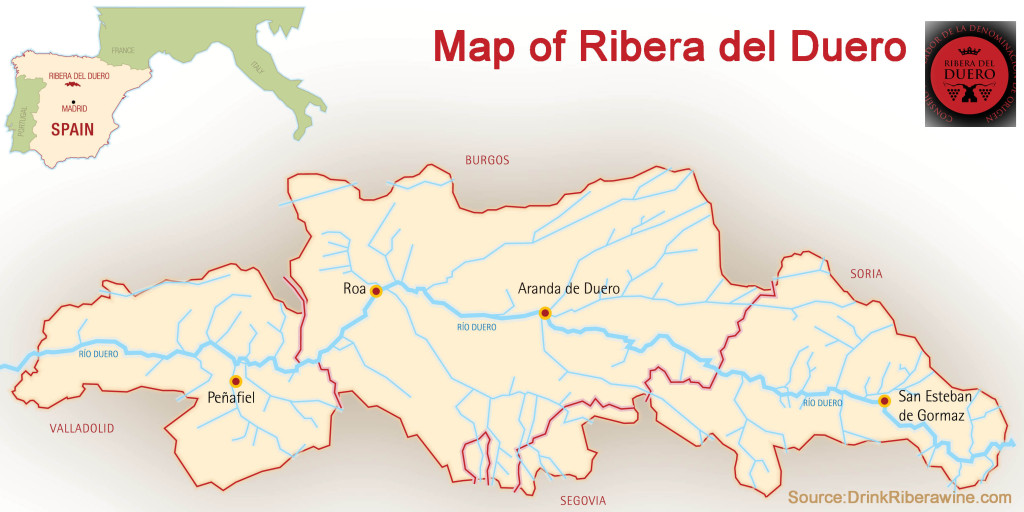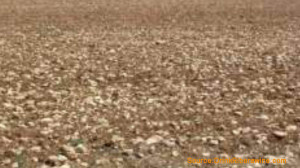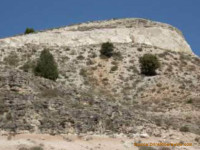The Denominacion de Origen (D.O.) Ribera Del Duero is located in Spain’s northern plateau. The D.O. crosses over the provinces of Castilla y Leon, Burgos, Segovia, Soria and Valladolid.
Ribera Del Duero (Ribera) translated into English means – river bank of the Duero. The Duero River Valley is 71 miles long and 22 miles wide. The D.O. vineyards are planted on both sides of the river from the Burgos province on the east to Valladolid to the west with some vineyards in Segovia in the south.
 A distinguishing character of the Ribera Del Duero wines from the rest of Spain is that the vineyards are planted at high altitudes. On average the vineyards are located from 2,100 to 2,500 feet above sea level with some vineyards as high as 3,100 feet above sea level. At these altitudes the vineyards have a diurnal range of temperatures.
A distinguishing character of the Ribera Del Duero wines from the rest of Spain is that the vineyards are planted at high altitudes. On average the vineyards are located from 2,100 to 2,500 feet above sea level with some vineyards as high as 3,100 feet above sea level. At these altitudes the vineyards have a diurnal range of temperatures.
Climate
The climate of the region is Mediterranean with Continental influences with a moderate rainfall of about 17 inches annually. Summers are short and hot with temperatures that can range from over 100F during the day to 50F to 60F at night. These temperature swings helps the grapes grow healthy and balances the sugars and acids in the grapes. It also enhances the aromatics that we find in our glasses.
Soil
 The soil conditions vary from the low lying areas of the river banks to along the steep slopes. The land along the river banks, are called Campania (countryside). Here the soils are mostly alluvial with sand and reddish clay. Above the Campania are the shallow slopes called Laderas (sides). This area is the best for growing the grape vines. The next level is steep sloped and is named Cuestas (slopes). This steepness of the slopes make it very difficult to plant on. Above the Cuestas is Paramos (meadow land). This level is flat and is used mainly for other agricultural purposes.
The soil conditions vary from the low lying areas of the river banks to along the steep slopes. The land along the river banks, are called Campania (countryside). Here the soils are mostly alluvial with sand and reddish clay. Above the Campania are the shallow slopes called Laderas (sides). This area is the best for growing the grape vines. The next level is steep sloped and is named Cuestas (slopes). This steepness of the slopes make it very difficult to plant on. Above the Cuestas is Paramos (meadow land). This level is flat and is used mainly for other agricultural purposes.
 Some grape vines are grown in this open exposed area. However, the best vineyards are on South eastern facing slopes.The higher vineyards have alternating layers of limestone, marl and chalk. Here in Ribera the limestone soil is the vineyards best friend in producing outstanding grapes. The limestone will bring more acidty to the wine.
Some grape vines are grown in this open exposed area. However, the best vineyards are on South eastern facing slopes.The higher vineyards have alternating layers of limestone, marl and chalk. Here in Ribera the limestone soil is the vineyards best friend in producing outstanding grapes. The limestone will bring more acidty to the wine.
Soils of the East
On the Paramos level, the soils are limestone and chalk.
The lower Laderas have soil of clay and marl
The lower Cuestas are limestone, clay, and marl
The upper Laderas are limestone and marl
Soils of the West:
On the Paramos level, the soils are chalk.
The lower Laderas are sand over clay
The lower Cuestas are marl with some gypsum
The upper Cuestas are marl and limestone
The higher altitude vineyards have alternating layers of limestone,marl and chalk. Here in Ribera del Duero, the limestone soil is the vineyards best friend in producing outstanding grapes along with the vineyards being planted on a south eastern facing slope. Generally you can find the best vineyards in the province of Burgos.
Grape Varieties
With this great soil and wild climate, the grape of Ribera del Duero is Tinto Fino. This grape is also known as Tempranillo. Being an early ripening grape it works well in the shortened growing season of the region. Tinto Fino represents about 95% of what is produced. Cabernet Sauvignon is about 1%. Merlot, Garnacha Tinta and Malbec combined are less than 1% of production. The white grape of Albillo is about 3% of production and is used for rosados.
Quality Control
In order to maintain the D.O. status, the wineries must follow the rules of the governing body known as the Consejo Regulador of D.O. Ribera Del Duero.
The Consejo Regulador starts monitoring each member in the vineyard ensuring that the maximum number of grapes per hectare are no greater than 7,000 Kg (3.1 tons). During the winemaking process they ensure that only the authorized grapes are being made into the wine. Now for the hard work, the wines are tasted before they are released to the consumers. The Consejo Regulador guarantees the authenticity of the wines by applying their D.O. numbered seal on the back of the bottle.
Wine Designations
Based upon the wines ageing, they are given the following designations.
Joven-wines that have not been kept in wood or which have spent less than 12 months in oak casks (barriques). These wines can reach the market as soon as three months after harvest.
Crianza-wines that have been in oak for at lest 12 months. They may not be sold until the first October 1 of the second year following the harvest.
Reserva -wines that have been ageing for at least 36 months between oak casks and bottle and at least 12 months in the oak cask. They may not be sold until December 1 of the third year following the harvest.
Gran Reserva-wines that have been ageing for at least 60 months between oak casks and bottle and at least 24 months in the oak cask and 36 months in bottle. They may not be sold until December 1 of the fifth year following the harvest.
Rosado-wines that are fermented with minimal skin contact. These are available for sale shortly after harvest.
Tempranillo (Tinto Fino) Flavor Profile in Ribera Del Duero
The variety of terroirs makes it difficult to specifically identify a standard profile. The wines from Ribera Del Duero have bolder expressions of Tempranillo. You will find aromas and flavors of blackberry, mulberry, black cherry, licorice and forest earthy notes. You can find spiciness from the use of oak barrels in the wine making process. You will find power and structure in each glass.
The Joven wines are full of fruit with freshness. The Crianza is aged enough where there are smooth tannins and a full bodied not so simple wine. Reserva wines are elegant. Gran Reserva wines are special wines. They are released when they are at the beginning of their drinking life with still many more years to develop in the bottle. They are wines with strong structure and complexities.
Click Here for Spanish Wine Reviews Including Ribera Del Duero Wine Reviews
